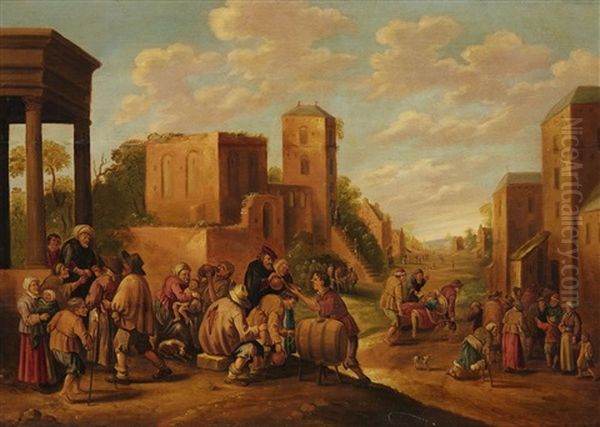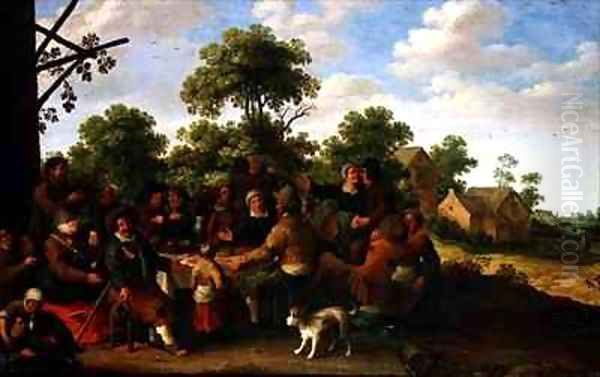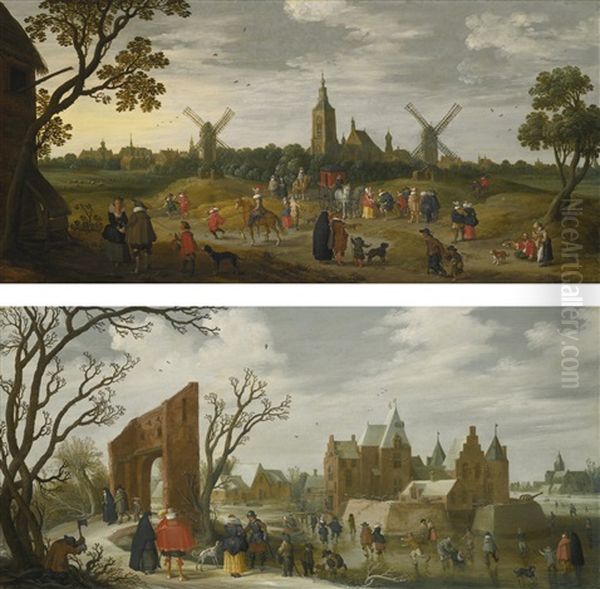
The Dutch Golden Age, spanning roughly the 17th century, was a period of extraordinary artistic flourishing in the Netherlands. Amidst masters renowned for portraiture, history painting, and dramatic light, Joost Cornelisz. Droochsloot carved a distinct niche for himself. Active primarily in Utrecht, Droochsloot (1586-1666) became a prolific and popular painter celebrated for his vibrant depictions of village life, genre scenes, and moral allegories, offering a detailed visual record of the rural world during this transformative era.
Early Life and Artistic Formation in Utrecht
Joost Cornelisz. Droochsloot was born in Utrecht in 1586, and the city would remain the center of his life and career until his death in 1666. While most sources confirm Utrecht as his birthplace, some minor conflicting accounts suggest Dordrecht or Gorinchem, though these remain less substantiated. His artistic journey formally began in 1616 when he was registered as a master in the Utrecht Guild of Saint Luke, the professional organization for painters and other artisans.
Droochsloot's artistic roots lie firmly within the Flemish landscape and genre traditions, which were highly influential in Utrecht during the early 17th century. His work shows a clear affinity with the style and subject matter of earlier masters, most notably Pieter Bruegel the Elder and his son Pieter Bruegel the Younger. Their detailed depictions of peasant life, festivals, and crowded village scenes provided a foundational model for Droochsloot's own compositions.
Further influences can be traced to Flemish artists who were active slightly earlier or contemporary to Droochsloot's formative years. David Vinckboons, known for his lively landscapes populated with numerous small figures and often depicting kermesses or biblical scenes set in contemporary landscapes, seems to have left a mark on Droochsloot's approach. Similarly, the work of Esaias van de Velde, a pioneer of Dutch realistic landscape painting, likely informed Droochsloot's rendering of local settings, although Droochsloot generally maintained a more narrative and densely populated style compared to Van de Velde's increasingly atmospheric focus.

While his influences are relatively clear, the identity of Droochsloot's specific teacher remains somewhat uncertain. Some art historians have speculated that he might have studied with David Vinckboons or perhaps even a member of the Francken family, such as Frans Francken the Younger, known for their detailed cabinet paintings often featuring historical or allegorical subjects with many figures. However, concrete documentary evidence confirming his apprenticeship under a specific master is lacking, leaving his early training partially shrouded in mystery. What is certain is that by the time he joined the Guild, he was equipped with the skills to establish a successful independent workshop.
Style and Thematic Focus: Villages, Morality, and Daily Life
Droochsloot developed a highly recognizable style characterized by bustling, panoramic views of village streets and squares. His compositions are typically filled with a multitude of small, animated figures engaged in various activities. He favored a relatively high viewpoint, allowing for a deep recession into space, often along a winding village road lined with rustic houses and trees. This compositional structure, reminiscent of the Bruegels, provided ample stage for his narrative inclinations.
His palette often features earthy tones, with figures frequently rendered in characteristic reddish-brown hues, set against the cooler greens and blues of the landscape and sky. While his figure drawing can sometimes appear somewhat formulaic or repetitive across his extensive oeuvre, the overall effect is one of energetic, teeming life. He possessed a keen eye for detail, capturing the textures of rural architecture, the clutter of market stalls, and the varied attire of the villagers.
Thematically, Droochsloot's work revolves around the depiction of rural and urban fringe life. Village feasts, peasant gatherings, market days, and kermesses (fairs) are recurrent subjects, providing opportunities to depict communal celebration and social interaction. These scenes are rarely just descriptive; they often carry underlying moral or social commentary, a common feature in Dutch genre painting of the period. He frequently contrasted the behavior of different social groups, sometimes highlighting charity and piety, other times depicting drunkenness, brawling, or indolence among the lower classes, perhaps serving as cautionary tales for the viewer.
Biblical stories and moral allegories also formed a significant part of his output, often transposed into contemporary Dutch settings. A particularly favored theme was The Seven Works of Mercy, which he painted multiple times. These works depict acts of charity such as feeding the hungry, clothing the naked, and visiting the sick, presented within a recognizable village or town environment, thereby directly linking religious duty to civic responsibility. Similarly, The Charity of St. Martin, showing the saint dividing his cloak for a beggar, was another subject he revisited.

Droochsloot also produced winter landscapes, often featuring skaters on frozen canals or rivers near a village, capturing the specific atmosphere and activities associated with the season in the Netherlands. These works showcase his ability to adapt his style to different conditions, using cooler colors and capturing the crisp light of a winter's day.
Among his representative works that encapsulate his style and themes are paintings titled Village Feast, The Seven Works of Mercy, and The Charity of St. Martin. Another notable work mentioned in records is Soldiers in the Square at Amersfoort, depicting military presence within a town setting, showcasing his versatility in subject matter beyond purely peasant scenes. Through these varied subjects, Droochsloot consistently provided a rich, albeit sometimes didactic, portrayal of the society he observed.
Career and Civic Engagement in Utrecht
Droochsloot was not merely a painter confined to his studio; he was an active and respected member of the Utrecht community. His involvement with the Guild of Saint Luke extended beyond simple membership. In 1623, he was elected as deacon (deken) of the Guild, a position of leadership responsible for administrative duties and upholding the standards of the craft. He may have held other senior roles, such as 'elder', within the Guild structure at different times.
His civic engagement further solidified his standing. In 1638, he took on the role of regent (regent) of the Sint Jobs Gasthuis (St. Job's Hospital), an institution dedicated to caring for those afflicted with syphilis and other ailments. Serving as a regent was a prestigious voluntary position typically held by affluent and respected citizens, involving oversight of the hospital's finances and operations. This appointment underscores Droochsloot's social status and commitment to civic welfare.
Later in life, his connection to Utrecht's civic structure continued. In 1665, towards the end of his long career, he became an officer (variously described as 'scherenier' or guard) of the Utrecht Schutterij, the city's civic militia. This role, while perhaps partly honorary at his advanced age, further demonstrates his integration into the fabric of Utrecht society.
Throughout these decades, Droochsloot maintained a productive workshop in Utrecht. The sheer volume of paintings attributed to him suggests a well-organized studio, possibly employing assistants or apprentices to help meet the demand for his popular village scenes. His consistent presence and active participation in Utrecht's artistic and civic life made him a well-known figure in the city throughout the mid-17th century.
Artistic Lineage and Influence

Joost Cornelisz. Droochsloot's influence extended through both his family and his pupils. His son, Cornelis Droochsloot (c. 1630–1673), followed in his father's footsteps and became a painter. Cornelis worked in a style very similar to his father's, focusing on the same types of village scenes and genre subjects. Their styles are so close, in fact, that distinguishing between the works of father and son can sometimes be challenging for art historians, particularly for paintings produced during the period when both were active.
Perhaps more significant in terms of broader artistic impact was Droochsloot's role as a teacher. His most notable pupil was Jacob Duck (c. 1600–1667), who likely studied with Droochsloot in the 1620s before becoming a master in the Utrecht Guild himself around 1621-1630. Duck went on to become a prominent genre painter in his own right, known for his depictions of guardroom scenes ('kortegaardjes') and elegant interior gatherings, often with a moralizing undertone. While Duck developed his own distinct style, characterized by smoother brushwork and a focus on different social settings, the narrative and genre elements likely owe something to his training under Droochsloot.
Within the context of the Utrecht school of painting, Droochsloot represented a continuation of the Flemish-influenced genre and landscape tradition. This stood somewhat apart from the other major trend in Utrecht during the early 17th century: Utrecht Caravaggism, practiced by artists like Hendrick ter Brugghen and Gerard van Honthorst, who had absorbed the dramatic chiaroscuro and realism of Caravaggio during their time in Italy. Droochsloot's style remained more rooted in Northern European traditions.
While Droochsloot's works were highly popular during his lifetime, particularly within Utrecht and the surrounding regions, his style eventually came to be seen by some later critics as somewhat repetitive or less innovative compared to the developments happening elsewhere in Dutch art. The rise of more 'elegant' or 'Italianate' landscape painting, associated with artists like Cornelis van Poelenburch and Jan Both (also from Utrecht but heavily influenced by Italy), represented a different aesthetic direction. Nevertheless, Droochsloot's contribution remained significant, particularly in popularizing and prolifically producing detailed scenes of local life that appealed to a broad market.
Droochsloot and his Contemporaries
The Dutch Golden Age was populated by a constellation of brilliant artists, and while Droochsloot was a significant figure in Utrecht, direct documented evidence of his interactions with some of the era's biggest names, like Rembrandt van Rijn (1606-1669), is lacking. Rembrandt worked primarily in Leiden and later Amsterdam, and while their careers overlapped significantly, there's no record of collaboration or direct personal contact between him and Droochsloot.
However, some indirect connections or parallels can be considered within the broader artistic milieu. One source snippet speculatively notes a stylistic similarity between Droochsloot's work and that of Pieter Lastman (1583-1633), who was Rembrandt's teacher in Amsterdam. Both Droochsloot and Lastman worked with detailed compositions featuring numerous figures, often in historical or biblical narratives. This might suggest shared roots in earlier narrative traditions or simply parallel developments rather than direct influence.
Droochsloot's primary artistic dialogue seems to have been with the Bruegel tradition and contemporaries working in similar veins. His focus on peasant genre scenes aligns him broadly with artists like Adriaen van Ostade or Adriaen Brouwer (though Brouwer was Flemish), who also depicted rural life, albeit often with a different psychological intensity or focus. Compared to the more varied and often humorous interior scenes of Jan Steen, Droochsloot's work is generally more focused on outdoor, communal village activities.
His landscapes, while distinct, exist within the rich context of Dutch landscape painting that included specialists like Jacob van Ruisdael and Meindert Hobbema, who achieved greater naturalism and atmospheric depth. Droochsloot's landscapes primarily serve as settings for human activity rather than being the main subject themselves, distinguishing his work from these dedicated landscape masters. His relationship with Utrecht contemporaries like the Caravaggisti (Ter Brugghen, Honthorst) and the Italianates (Poelenburch, Both) was one of stylistic divergence, highlighting the diversity within even a single city's artistic output during the Golden Age. Aelbert Cuyp, working mainly in Dordrecht, represents another strand, known for his idyllic landscapes bathed in golden light, quite different from Droochsloot's bustling village scenes.
Legacy and Collections
Joost Cornelisz. Droochsloot's enduring legacy lies in his vast output of paintings that vividly document the appearance and activities of Dutch villages and their inhabitants in the 17th century. While perhaps not reaching the innovative heights of some of his contemporaries, his work provides an invaluable visual resource for understanding the social fabric, customs, and physical environment of the period. His consistent focus on themes of charity and morality also reflects the preoccupations of his society.
His popularity during his lifetime and continued recognition are evidenced by the presence of his works in numerous public collections across Europe. The Rijksmuseum in Amsterdam holds a significant group of his paintings (reportedly six). His native Utrecht honors him with four works in the Centraal Museum. Other major institutions housing his paintings include the Museum of Fine Arts in Budapest (at least one work) and the Nationalmuseum in Stockholm (at least one work). Many other regional museums in the Netherlands and galleries abroad also count Droochsloot paintings among their holdings.
Beyond museum collections, a substantial number of Droochsloot's works reside in private hands. His paintings appear regularly on the art market, attesting to a continued interest among collectors. Auction records show consistent sales over the years. For example, works described as village scenes or landscapes attributed to him have fetched prices typically ranging from several thousand to low tens of thousands of euros in recent decades, depending on size, quality, condition, and subject matter. Specific examples include sales around €8,000-€12,000 for characteristic village scenes in auctions from the early 2000s to the 2010s, and estimated values in a similar range for works offered more recently. The provenance of some works can be traced through various collections and sales over centuries, like the mentioned Soldiers in the Square at Amersfoort or The Seven Works of Mercy.
Conclusion
Joost Cornelisz. Droochsloot stands as a key figure in the Utrecht school of painting and a significant contributor to the genre and landscape painting of the Dutch Golden Age. Born and based in Utrecht throughout his long life, he absorbed the influence of the Bruegel dynasty and Flemish traditions, developing a distinctive style focused on lively, detailed depictions of village life. His works are characterized by crowded compositions, narrative detail, and often a moralizing undertone, reflecting the values and social realities of his time. As a respected citizen, Guild leader, hospital regent, and teacher to artists like Jacob Duck, Droochsloot was deeply embedded in his community. While perhaps overshadowed by the era's greatest innovators, his prolific output ensures his place as an indispensable visual chronicler of 17th-century Dutch society, whose works continue to be appreciated in museums and collections worldwide.